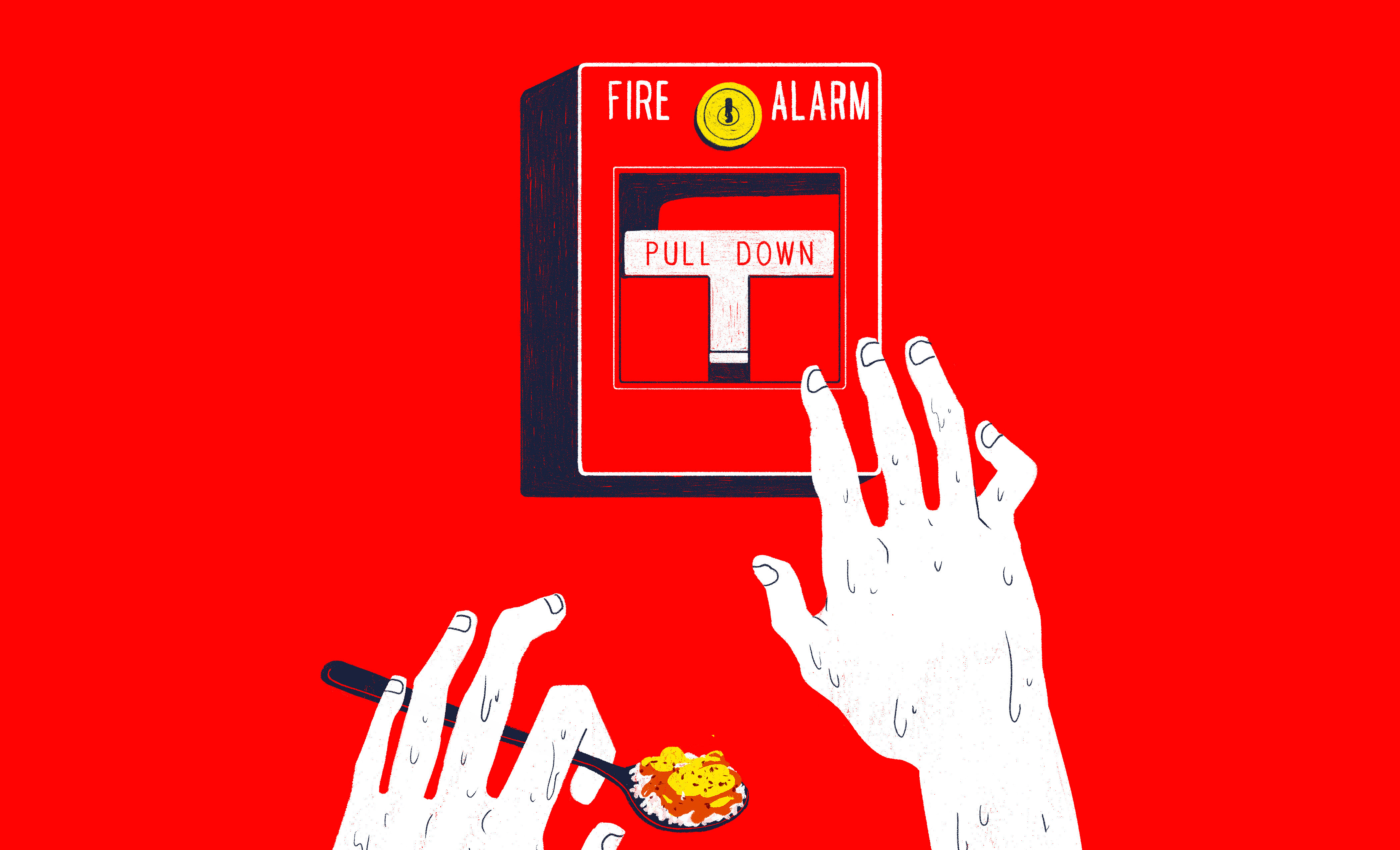如何真正享受辛辣食物带来的'痛并快乐着'?
How to Actually Enjoy the Painful Pleasure of Spicy Food
By Kristin Wong
 Illustration by Angelica Alzona
Illustration by Angelica Alzona
If you’re someone who believes that spicy food is the best food, we don’t have to convince you of its wonders. But not everyone is on board. Between the painful capsaicinoids, the bloating from drinking too much water, and the inevitable sweating, spicy food can also be uncomfortable to eat. Here are some tips to enjoy the spice without the bloating, sweat, and tears.
Why we love spicy food
Pain is part of the reason spicy food is so damn good. The sensation that your ears are bleeding only adds to the experience, making your curry or buffalo wings or salsa not just tasty, but flavorful.
What’s the difference between taste and flavor? Flavor depends on three factors: taste (whether something is sour, salty or sweet), olfactory sense (the smell of the food), and trigeminal sense—the way your nerves sense that food. Capsaicin, the active component in hot peppers, stimulates your pain receptors, making you think the food is hot. Of course, you’re not actually being burned; it’s the perception of pain.
Capsaicin can also make you feel like you’re high. When your mouth’s pain receptors are activated, they cause your body to release dopamine and endorphins (you have these receptors in your butt, too). This whole process explains why we love the experience of spicy food, not just the taste. The perceived pain of capsaicin adds to the flavor. Pain isn’t a bug, it’s a feature!
As much as this sensation adds to the experience, though, the discomfort can put the brakes on your ability to enjoy the meal. You take a swig of water after every bite, and halfway through, you’re too bloated and miserable to go on. You want the flavor, but you want to be able to actually enjoy it.
It seems like a culinary Catch-22, but there are a few ways to get the best of both worlds.
Build your tolerance
It’s not just a myth: you can indeed build a tolerance for spicy food. When you repeatedly expose your pain receptors to capsaicin, they physically change, allowing you to up your spice game.
Discover magazine explains:
When exposed to capsaicin, these receptors open to allow in sodium and calcium ions, causing the receptors to transmit that hot signal to the brain. However, with repeated short-term exposure to capsaicin, those calcium ions essentially close the receptor door behind them, inhibiting further transmission of pain signals. Over the long term, with repeated spicy meals, the whole nerve ending starts to degrade in a way scientists are still trying to understand.
The nerves can grow back, though, which is good, but it also means you need a regular diet of spicy food to maintain your tolerance, Discover explains.
The answer here is pretty simple: eat spicy food more often. Serious Eats suggests adding spice gradually. Sprinkle some red pepper flakes into your soup. Add more black pepper to your meals. For those that really can’t do spicy, one health practitioner even suggested spiking ketchup with a couple of drops of Tabasco.
Use the right coolants
Of course, when you build your tolerance, you risk losing some of the flavor that comes with your trigeminal sense. So if you want to keep your receptors intact (or you’re haven’t built up a tolerance yet), there are ways to deal with the heat rather than grow numb to it. Namely, you want to find the right coolants to ease the perceived pain. And it’s not water, soda, or juice. It’s more like milk.
Capsaicin is fat-soluble, not water-soluble. In a paper published in Pharmacological Reviews, scientists explained:
Because capsaicin is not water-soluble, alcohols and other organic solvents are used to solubilize capsaicin in topical preparations and sprays. This liposolubility is likely to explain why an oral excess of capsaicin in food is not alleviated by drinking water, whereas a yogurt-based drink, such as a lassi, is able to remove the vanilloid from the mouth.
Over at Thrillist, writer Michelle No tested 10 different coolants and found whole milk and coconut water to be a couple of the most effective remedies, too.
Other food items that can extinguish the fire in your mouth: sugar, rice, sour cream, honey and acids like lime.
The reason we bloat on water over a spicy meal is because we drink so damn much of it and it’s not effective. Swap out your coolant and it will take less liquid to ease the pain.
Slow down
Finally, here’s a simple idea for enjoying the heat: eat slowly. Or at least slower. As The Kitchn points out, the more capsaicin you eat, the stronger the reaction, so when you slow down, you maintain a “steady but tolerable amount” in your body.
The effect of spicy food only lasts for about 15 minutes or so, so if you’re snacking, it might help to just be mindful of this. Let the heat pass, then go back for more.
As much as you may love the sensation of capsaicin hitting your tongue, the discomfort can take over and make it impossible to enjoy your meal. The trick is to find a balance between actually scarfing down the tasty food and making yourself miserable because the spice is just too much. These tips should be able to help you find that balance—just the right amount of pain to add to the flavor, rather than take it over completely.